This 1863 manual wasn't scanned by us, but by Thomas Jefferson University in Philadelphia. They've got three books in total available for download:
# A manual of military surgery, [Confederate States Army], 1863
# A manual of military surgery, by S.D. Gross, MD, 1861
# On the anatomy of the breast, by Sir Astley Paston Cooper, 1840
An unofficial blog about the National Museum of Health and Medicine (nee the Army Medical Museum) in Silver Spring, MD. Visit for news about the museum, new projects, musing on the history of medicine and neat pictures.
Friday, March 21, 2008
William Hunter and the Art and Science of Eighteenth-Century Collecting
William Hunter and the Art and Science of Eighteenth-Century Collecting Conference
3-5 September 2008
A conference organised by the Hunterian and the University of Glasgow History of Art Department which will explore Dr William Hunter's role and place as a collector in eighteenth-century Europe.
Wednesday 3 September - Hunterian Art Gallery 4.00. Registration/coffee/tea; 4.30- 5.30 Keynote speaker: t.b.c.
5.45-7.00 Reception, Hunterian Art Gallery. Curators Peter Black and Anne Dulau give tours of exhibitions.
Thursday 4 September- Hunterian Museum. Session 1: European private collections.
Speakers include: Mikael Ahlund (Nationalmuseum, Stockholm); Heiner Krellig (Berliner Schlosser); Guillaume Faroult (Louvre); Kim Sloan (Francis Finlay Curator of the Enlightenment Gallery, British Museum)
Session 2: Medical 'men' as collectors and medical collections.
Stuart McDonald (IBLS - Neuroscience & Biomedical Systems, University of Glasgow); Peter Black (Curator, Hunterian Art Gallery); Starr Douglas (Leverhulme Scholar, University of Glasgow); Simon Chaplin (Director of the Museum and Special Collections at the Royal College of Surgeons)
Friday 5 September - Hunterian Museum. Session 3: 18th Century museums and collections.
Architecture, Interiors and Display; Helen McCormack (David Carritt Scholar, University of Glasgow); Clare Haynes (School of World Art Studies and Museology, University of East Anglia); Geoff Hancock (Curator of Entomology, Hunterian Museum); Tom Tolley (History of Art Department, University of Edinburgh).
Session 4: 'A centre of instruction and enlightenment'.
Hunter and his collections: David Weston (Keeper, Glasgow University Library Special Collections) Hunter's library 2.30 Donal Bateson (Curator of Coins & Medals, Hunterian Museum); Nick Pearce (History of Art Department, University of Glasgow); John Faithfull (Curator of Mineralogy, Hunterian Museum)
For further information contact Geoff Hancock
Telephone: 0141 330 2194
Email:G.Hancock@museum.gla.ac.uk
www.hunterian.gla.ac.uk
3-5 September 2008
A conference organised by the Hunterian and the University of Glasgow History of Art Department which will explore Dr William Hunter's role and place as a collector in eighteenth-century Europe.
Wednesday 3 September - Hunterian Art Gallery 4.00. Registration/coffee/tea; 4.30- 5.30 Keynote speaker: t.b.c.
5.45-7.00 Reception, Hunterian Art Gallery. Curators Peter Black and Anne Dulau give tours of exhibitions.
Thursday 4 September- Hunterian Museum. Session 1: European private collections.
Speakers include: Mikael Ahlund (Nationalmuseum, Stockholm); Heiner Krellig (Berliner Schlosser); Guillaume Faroult (Louvre); Kim Sloan (Francis Finlay Curator of the Enlightenment Gallery, British Museum)
Session 2: Medical 'men' as collectors and medical collections.
Stuart McDonald (IBLS - Neuroscience & Biomedical Systems, University of Glasgow); Peter Black (Curator, Hunterian Art Gallery); Starr Douglas (Leverhulme Scholar, University of Glasgow); Simon Chaplin (Director of the Museum and Special Collections at the Royal College of Surgeons)
Friday 5 September - Hunterian Museum. Session 3: 18th Century museums and collections.
Architecture, Interiors and Display; Helen McCormack (David Carritt Scholar, University of Glasgow); Clare Haynes (School of World Art Studies and Museology, University of East Anglia); Geoff Hancock (Curator of Entomology, Hunterian Museum); Tom Tolley (History of Art Department, University of Edinburgh).
Session 4: 'A centre of instruction and enlightenment'.
Hunter and his collections: David Weston (Keeper, Glasgow University Library Special Collections) Hunter's library 2.30 Donal Bateson (Curator of Coins & Medals, Hunterian Museum); Nick Pearce (History of Art Department, University of Glasgow); John Faithfull (Curator of Mineralogy, Hunterian Museum)
For further information contact Geoff Hancock
Telephone: 0141 330 2194
Email:G.Hancock@museum.gla.ac.uk
www.hunterian.gla.ac.uk
Pharmacology as a technology
Coincidentally the NY Times reported on the deaths of two men who developed drugs for treating mental states.
The articles are:"Frank Ayd, 87, Who Advanced Thorazine Use, Is Dead,", by DOUGLAS MARTIN, March 21, 2008.
Dr. Ayd studied his patients’ responses to early antipsychotic and antidepressant drugs, helping to give birth to the field of psychopharmacology.
and: "Frank Berger, 94, Miltown Creator, Dies," By BENEDICT CAREY, March 21, 2008.
Dr. Berger helped start the modern era of drug development with his invention of Miltown, the first mass-market psychiatric drug and a forerunner of Valium and Prozac.
These two obituaries show what a short time has passed since mind and mood altering drugs, besides alcohol, were developed and have become common, helping millions of people, but leading to many debates over the proper use of them. For thousands of years, medicine used some basic drugs and these didn't change much. In the 19th and 20th century, that was no longer true, and a new branch of the history of medicine opened up.
The articles are:"Frank Ayd, 87, Who Advanced Thorazine Use, Is Dead,", by DOUGLAS MARTIN, March 21, 2008.
Dr. Ayd studied his patients’ responses to early antipsychotic and antidepressant drugs, helping to give birth to the field of psychopharmacology.
and: "Frank Berger, 94, Miltown Creator, Dies," By BENEDICT CAREY, March 21, 2008.
Dr. Berger helped start the modern era of drug development with his invention of Miltown, the first mass-market psychiatric drug and a forerunner of Valium and Prozac.
These two obituaries show what a short time has passed since mind and mood altering drugs, besides alcohol, were developed and have become common, helping millions of people, but leading to many debates over the proper use of them. For thousands of years, medicine used some basic drugs and these didn't change much. In the 19th and 20th century, that was no longer true, and a new branch of the history of medicine opened up.
Anatomical brushes for Photoshop
I'm a struggling Photoshop Elements 6 learner. I'm always on the prowl for ways to level the learning curve so I subscribed to several Photoshop blogs. One that popped up today offers brushes (which I'm not really sure what they are but think they're something like virtual rubber stamps) of "... a mix of drawings (apparently drawn by Leonardo da Vinci...) and photos of 18th century wax anatomy sculptures (from Florence's Museo La Specola). Perhaps not for the very faint hearted, but interesting nonetheless."
I saw them mentioned on The Photoshop Blog. The brushes are being offered by a designer in France, who asks only that you link back to her when you use her brushes. In addition to these she also has a couple sets of skulls and bones, and a lot of non-anatomical sets too.
If only I could figure out how to show those brushes in this post.
I saw them mentioned on The Photoshop Blog. The brushes are being offered by a designer in France, who asks only that you link back to her when you use her brushes. In addition to these she also has a couple sets of skulls and bones, and a lot of non-anatomical sets too.
If only I could figure out how to show those brushes in this post.
Thursday, March 20, 2008
Woolly Skeletons
Awesome blog Street Anatomy, which I will admit, I've taken a liking to in recent days, links to some cool anatomical constructs made of felted wool! (Worth the exclamation point? Don't know. Left it in anyway.)
Some Blog Coverage Today
A blog post about prosthetics, with just a twinge of commentary thrown in, mentions the Museum with several choice photographs, apparently taken with a keen eye by the blog's author. Thanks, DC Confidential, for the nice write-up and link. And we'll look out for those future posts the author mentions.
This week's flickr pictures
Kathleen and I have been putting up a few pics this week as the fancy has struck us. Check these out:
March 17th:
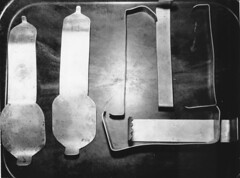
Retractors made from scrap metal. 44th Field Hospital, 8th Detachment. World War 2. 09/23/1945.
March 18:

"Gunshot fracture of left superior maxilla." Private Henry Morgan, Co. D, 77th New York Volunteers, wounded at Petersburgh, VA on April 2, 1865. Treated at Harewood Hospital, Washington DC, by Dr. Reed B. Bontecou who also had the photograph made.
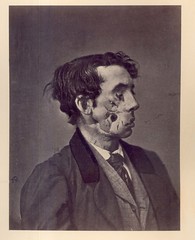
"Shell Wound of the face, with great destruction of the soft parts." Private Joseph Harvey, Co. C, 149th New York Volunteers. Wounded at Chancellorsville, Virginia on May 3 1863.
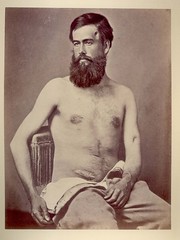
"Case of Corporal Bemis, Thrice Severely Wounded in Three Battles." Cpl. Edson D. Bemis, Co. K, 12th Massachussetts, wounded at Battles of Hatcher's Run, the Wilderness and Antietam.
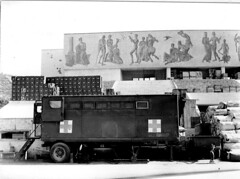
Mobile Optical Unit. 4th Medical Depot, Italy. 06/07/1944.
March 19:

Detachment of Hospital Corps taking patients over obstacles on the way to the hospital. Illustrating the equipment and operation of the brigade field hospital. Exhibit of the Army Medical Department, Pan-American Exposition, Buffalo, New York, 1901.

"Saboteuse" - World War II venereal disease prevention poster by editorial cartoonist C.D. Batchelor for the American Social Hygiene Association.
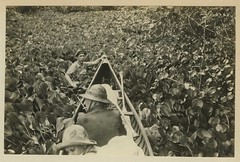
Panama. Dr. H.C. Clark. Gorgas Hospital. Ancon, Canal Zone. Club canoe forcing way through hyacinth beds, Pacora.
March 20:
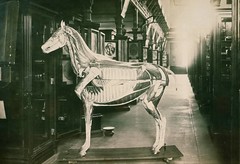
Comparative anatomy, Auzoux model of horse, life size. Specimen no. 2635. [papier mache, on display in Army Medical Museum] (We no longer have the model, although one can be seen in the Science Museum in London. This one's for Morbid Anatomy).

An enlisted technician rides along with patient to ground level to insure safety. from a series: "Air Evacuation from China to India," Patients flown over the 'hump' from China to India to be admitted to the 142nd General Hospital for further disposition.
More information about each picture can be seen on our flickr site. Visit our 3rd flickr page regularly, or sign up to be a contact so you know when new pictures go up.
March 17th:

Retractors made from scrap metal. 44th Field Hospital, 8th Detachment. World War 2. 09/23/1945.
March 18:

"Gunshot fracture of left superior maxilla." Private Henry Morgan, Co. D, 77th New York Volunteers, wounded at Petersburgh, VA on April 2, 1865. Treated at Harewood Hospital, Washington DC, by Dr. Reed B. Bontecou who also had the photograph made.

"Shell Wound of the face, with great destruction of the soft parts." Private Joseph Harvey, Co. C, 149th New York Volunteers. Wounded at Chancellorsville, Virginia on May 3 1863.

"Case of Corporal Bemis, Thrice Severely Wounded in Three Battles." Cpl. Edson D. Bemis, Co. K, 12th Massachussetts, wounded at Battles of Hatcher's Run, the Wilderness and Antietam.

Mobile Optical Unit. 4th Medical Depot, Italy. 06/07/1944.
March 19:

Detachment of Hospital Corps taking patients over obstacles on the way to the hospital. Illustrating the equipment and operation of the brigade field hospital. Exhibit of the Army Medical Department, Pan-American Exposition, Buffalo, New York, 1901.

"Saboteuse" - World War II venereal disease prevention poster by editorial cartoonist C.D. Batchelor for the American Social Hygiene Association.

Panama. Dr. H.C. Clark. Gorgas Hospital. Ancon, Canal Zone. Club canoe forcing way through hyacinth beds, Pacora.
March 20:

Comparative anatomy, Auzoux model of horse, life size. Specimen no. 2635. [papier mache, on display in Army Medical Museum] (We no longer have the model, although one can be seen in the Science Museum in London. This one's for Morbid Anatomy).

An enlisted technician rides along with patient to ground level to insure safety. from a series: "Air Evacuation from China to India," Patients flown over the 'hump' from China to India to be admitted to the 142nd General Hospital for further disposition.
More information about each picture can be seen on our flickr site. Visit our 3rd flickr page regularly, or sign up to be a contact so you know when new pictures go up.
David Challinor's obituary

I never met, nor to be honest, had heard of Dr. David Challinor of the Smithsonian before reading his obituary yesterday. These sentences caught my eye:
He also wrote more than 200 " Letters from the Desk of David Challinor" that are in the Smithsonian's digital repository and available online. They address issues such as flu pandemics, tree ecology, bird song accents and dialects, the nature of trust, hydrothermal vents and "good smells and bad."
I read the bird flu article today - it's a good summation. As you can see by downloading some of those World War 1 medical histories that have been linked to here previously, the Army Medical Museum was quite concerned with investigating the 'Spanish flu' in 1918, and specimens preserved then were used by AFIP scientists to genotype that flu in the 1990s, demonstrating one value of a museum collection. You can see the Museum's flu pictures on the main website.

And speaking of telemedicine...
...today's Washington Times had a piece on teleradiology - "Outsourcing images," by Shelley Widhalm (March 20, 2008) that talks about some of the issues, ethical and practical, involved in the practice. It's a bit of a puff piece for an area business, but gets across the points one should think about.
My earlier post on telemedicine is here.
My earlier post on telemedicine is here.
Whatever happened to... J. Carey Crane?
Another alum report - Carey was our exhibits head, but left us to go west. Carey had been the Curator of Exhibits at the Alamagordo Space Museum, but reports the "Latest twist in my checkered career: Senior Exhibits Curator for the City of Las Cruces' Museum system. Las Cruces is creating a complex including art, history, natural history museums. Several historic buildings including a railroad depot are close by."
Wednesday, March 19, 2008
What is...Street Anatomy, Alex?
For $200: A blog that that features depictions of human anatomy in various outdoor settings.
(I wonder if I would have come across something like this in any of my previous jobs...no, probably not. Cool, eh?)
Tip: Medgadget
(I wonder if I would have come across something like this in any of my previous jobs...no, probably not. Cool, eh?)
Tip: Medgadget
Identifying war dead
The anatomical collections staff of the Museum is working on an exhibit about identifying American military war dead. The New York Times ran an interesting piece about the dead of other nationalities who were buried in Thailand in mass graves when they died during World War II building the 'Death Railway' and 'the bridge over the River Kwai.'
“It is almost forgotten history,” said Sasidaran Sellappah, a retired plantation manager in Malaysia whose father was among 120 Tamil workers from a rubber estate forced to work on the railway. Only 47 survived.
“It is almost forgotten history,” said Sasidaran Sellappah, a retired plantation manager in Malaysia whose father was among 120 Tamil workers from a rubber estate forced to work on the railway. Only 47 survived.
Tuskegee syphilis study - medical history that still has repercussions
This article "Testing after Tuskegee," by Amanda Thomas, Washington Times March 19, 2008, looks at the question of if the Tuskegee syphilis studies, unethical longitudinal studies that withheld treatment for syphilitic patients when an effective one existed, keeps black participation lower in clinical trials today.
Medical book exhibit in Australia
Medical books, with their interesting illustrations, make an easy exhibit subject. Here's an article about one at the University of Melbourne's Medical History Museum. Who knew they had a medical museum? We've got to get better organized.
Indiana Medical History Museum
Ange, a volunteer from the Indiana Medical History Museum, has written in to tell us that she's been posting pictures of their collection on flickr as well. I've been there - it's on the outskirts of Indianapolis - and it's a very cool place. In fact, I've referred film crews there because they still have a Victorian-type operating theatre.
Doctor's Day at the National Museum of Health and Medicine on March
Doctor's Day at the National Museum of Health and Medicine on March 30th!
In honor of Doctor's Day on Sunday, March 30, doctors and their families are invited to visit the National Museum of Health and Medicine for a special docent-led tour of our current exhibitions. A discovery cart activity showcasing plastinated human organs will also be featured. Doctor's Day observances date back to March 30, 1933, and mark the anniversary of the first use of general anesthesia in surgery.
Tours begin at 1:00 p.m. Admission and parking are free! Reservations are strongly recommended; phone (202) 782-2456 or email nmhminfo@afip.osd.mil in advance. Learn more about the Museum online at http://nmhm.washingtondc.museum. See you at the Museum!
What: Doctor's Day at the Museum!
Where: National Museum of Health and Medicine/AFIP, Building 54, Walter
Reed Army Medical Center
Date: Sunday, March 30, 2008
Time: 1:00 p.m.
In honor of Doctor's Day on Sunday, March 30, doctors and their families are invited to visit the National Museum of Health and Medicine for a special docent-led tour of our current exhibitions. A discovery cart activity showcasing plastinated human organs will also be featured. Doctor's Day observances date back to March 30, 1933, and mark the anniversary of the first use of general anesthesia in surgery.
Tours begin at 1:00 p.m. Admission and parking are free! Reservations are strongly recommended; phone (202) 782-2456 or email nmhminfo@afip.osd.mil in advance. Learn more about the Museum online at http://nmhm.washingtondc.museum. See you at the Museum!
What: Doctor's Day at the Museum!
Where: National Museum of Health and Medicine/AFIP, Building 54, Walter
Reed Army Medical Center
Date: Sunday, March 30, 2008
Time: 1:00 p.m.
Telemedicine at its most basic
Telemedicine is one of those buzzwords these days, and if you've checked into a hospital for x-rays after say 7 pm, you may very well have participated in it. Radiology is all digital these days - no film anymore - and India with its quotient of well-trained doctors is wide awake at midnight on the US East coast.
But here's another, more personal example from the Washington Times. In The doctor's online 'office' from March 18, 2008 by Karen Goldberg Goff, you can read about Dr. Howard Stark's embrace of the Internet to make life and medicine easier for everyone involved. Up to and including, "I once had a patient who worked for the WorldBank who called me from the airport in Kazakhstan," he says. "He had an abdominal hernia and was
in tremendous pain. I talked him through pushing in his own hernia on the floor of the airport."
Now that's telemedicine.
But here's another, more personal example from the Washington Times. In The doctor's online 'office' from March 18, 2008 by Karen Goldberg Goff, you can read about Dr. Howard Stark's embrace of the Internet to make life and medicine easier for everyone involved. Up to and including, "I once had a patient who worked for the WorldBank who called me from the airport in Kazakhstan," he says. "He had an abdominal hernia and was
in tremendous pain. I talked him through pushing in his own hernia on the floor of the airport."
Now that's telemedicine.
Women's History Month lecture at the National Museum of Health and Medicine!
Women's History Month at the National Museum of Health and Medicine!
Plan now to enjoy a special lecture on women and the American Red Cross. Thomas B. Goehner, Manager, Historical Outreach American Red Cross National Headquarters, will discuss "American Red Cross Women: Embracing Opportunity," on March 26, 2008 at 11:00 a.m. in Russell Auditorium at the NMHM.
From the time of Clara Barton to the present, the American Red Cross has offered women opportunities for leadership, travel, independence, volunteerism and professional growth. Wherever the Red Cross is serving--either on the battlefront or the home front--women continue to embrace and achieve success with each new challenge. This talk will celebrate the achievements and unique opportunities given to women through the Red Cross, shedding light on the contributions of rank-and-file Red Cross women as well as the pioneers from the past, like Clara Barton and nursing legend Jane Delano.
Admission is free!
What: Women's History Month Lecture: "American Red Cross Women:
Embracing Opportunity"
Where: Russell Auditorium, National Museum of Health and Medicine/AFIP,
Building 54, Walter Reed Army Medical Center
Date: Wednesday, March 26, 2008
Time: 11:00 a.m.
For more information, call (202) 782-2456 or email nmhminfo@afip.osd.mil. Learn more about the Museum online at http://nmhm.washingtondc.museum.
Plan now to enjoy a special lecture on women and the American Red Cross. Thomas B. Goehner, Manager, Historical Outreach American Red Cross National Headquarters, will discuss "American Red Cross Women: Embracing Opportunity," on March 26, 2008 at 11:00 a.m. in Russell Auditorium at the NMHM.
From the time of Clara Barton to the present, the American Red Cross has offered women opportunities for leadership, travel, independence, volunteerism and professional growth. Wherever the Red Cross is serving--either on the battlefront or the home front--women continue to embrace and achieve success with each new challenge. This talk will celebrate the achievements and unique opportunities given to women through the Red Cross, shedding light on the contributions of rank-and-file Red Cross women as well as the pioneers from the past, like Clara Barton and nursing legend Jane Delano.
Admission is free!
What: Women's History Month Lecture: "American Red Cross Women:
Embracing Opportunity"
Where: Russell Auditorium, National Museum of Health and Medicine/AFIP,
Building 54, Walter Reed Army Medical Center
Date: Wednesday, March 26, 2008
Time: 11:00 a.m.
For more information, call (202) 782-2456 or email nmhminfo@afip.osd.mil. Learn more about the Museum online at http://nmhm.washingtondc.museum.
Internet Archive (archive.org)
As you know, we've been uploading books that we've digitized to the Internet Archive's collection of about 350,000 books. Today Wired.com had an article about the Archive, describing the page-by-tedious-page scanning that's being done there. It's nice to know that even the Big Boys are doing it a page at a time.
Tuesday, March 18, 2008
Another Veterinary Corps researcher
A short while ago I wrote about Mike Lemish, who's interested in Military Working Dogs used in Vietnam, and said there was another researcher who's found some treasures in our Veterinary Corps collection. Greg Krenzelok's interest lies with the Corps during World War 1, when his grandfather, Sergeant Leonard Patrick Murphy served, and he has a web page where he relates what he's found and solicits information that others are willing to pass along. His particular interest lies with the horses used during the war, and is looking for pictures such as this one showing a horse being prepared for surgery.
Reeve 14727
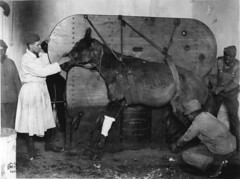
Reeve 14727

Subscribe to:
Posts (Atom)